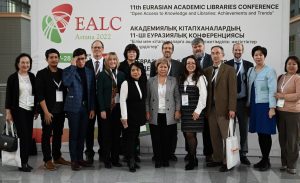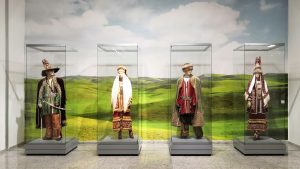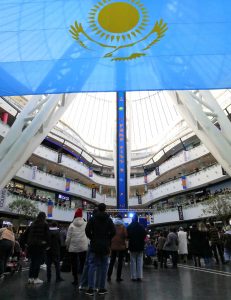
Recently, I was honored to deliver one of three keynote addresses at Nazarbayev University’s 11th Eurasian Academic Libraries Conference (EALC) in Astana, Kazakhstan.
The conference theme was Open Access to Knowledge and Libraries: Achievements and Trends. Often in my work with IFLA I’m engaged with developing copyright policy, focusing on where things are going wrong and how they could be improved. Hearing speakers from around Central Asia enthusiastically and the world discuss OA, repository development, and other related ongoing projects, it felt like I had entered a space where OA and related policies were the norm and traditional publishing modes were the alternative. It clearly showed the vitality and utility of OA.
Many Central Asian universities represented at the conference were founded or expanded relatively recently – including conference host Nazarbyaev University, which was established 2010. Open policies enable students and researchers to tap directly into the global, scholarly conversation in places that haven’t necessarily had decades to develop print collections, and journal subscriptions can be expensive and otherwise challenging to obtain. Access to current, up-to-date material enables everyone join and contribute to the global scholarly conversation.
There was a carefully chosen flow to the speakers, who were drawn from throughout the region and world. The conference featured simultaneous translation between Kazakh, Russian, and English – the three languages of Kazakhstan. The keynote addresses moved from my general discussion of the history of copyright. Broadly speaking, copyright law has always had a public interest goal in the diffusion of knowledge, and in the 20th and 21st centuries a lot of countries adopted or expanded rightsholder interests without paying adequate attention to the vital ‘limitations and exceptions’ that enable user access. In addition to my policy and advocacy role (email me at matt.voigts@ifla.org!), IFLA offers a variety of resources, including our recently-published, 576-page guide to copyright for libraries and statement in support of Open Access.
After my talk, the second keynote Paola Corti (SPARC Europe) discussed Open Access Policy and the third, Ray Uzwyshyn (Mississippi State University), discussed technical aspects of repository implementation. Ray is a standing committee member of IFLA’s Information Technology (IT) Section and editor of its Trends and Issues in Library Technology (TILT) bulletin (see recent issues from June and January 2022). Without meaning to leave out other conference speakers’ many contributions, I was particularly interested in hearing Zhyldyz Bekbalaeva (American University of Central Asia, Kyrgyzstan) speak on the specifics of development of ‘open’ initiatives at her university library, and Celia Emmelhainz (the Smithsonian’s US National Anthropological Archives, and formerly of Nazarbayev University Library) talk on critical considerations in deciding which of their collections they should make widely available.
The conference marked my first visit to central Asia. Reading the city through my own anthropological background, I saw the (often material) construction of ideas about 21st-century nationhood in development, reaching back to a vision of the past. While the southern city of Almaty is Kazakhstan’s ‘old capitol’, Astana (which changed its name from Nur-Sultan in September) as it is today largely developed since the country’s first president, Nursultan Nazarbayev, moved the capitol there in 1997. Around 750,000 people were expected to call it home, while today 1.3 million people live there. Astana seems like a capitol city like many others, where people move for opportunity amid the attendant pressures of urban life. It is also the world’s second-coldest capital (after Ulaanbaatar, Mongolia), and marked by a sense of seeming full of people, vibrant and somewhat empty all at once.
The globally-recognized architects who designed Astana built a city in part futuristic, in part steeped in global art and culture signifiers – including an Italian-inspired opera house, where I was lucky enough to see a production of La Traviata with production design featuring a giant mirror that reflected the entirety of otherwise-obscured parts of the stage. Housing and business developments have names of global cities such as Budapest and sprawl over the ever-expanding edges of the city. Some buildings are all sleek glass. One displayed Blade Runner-style projections on the side. Distinct landmarks incorporate central Asian motifs and include the tent-like Khan Shatyr shopping center and Bayterek Tower, with a gold ball on top designed to evoke the nest of the mythic samruk bird.
This mix of the futuristic and historically-evocative elements extended to conferences. My hotel was coincidentally hosting a med-tech conference, complete with an astronaut-suited industry rep walking as if in zero gravity and a 9-am chamber quartet. I was likewise very excited to try regionally-characteristic foods, including besbarmaq and smoky horse yogurt.
Thanks for a wonderful conference – and I (and IFLA) plan to continue work with Central Asia’s libraries.







